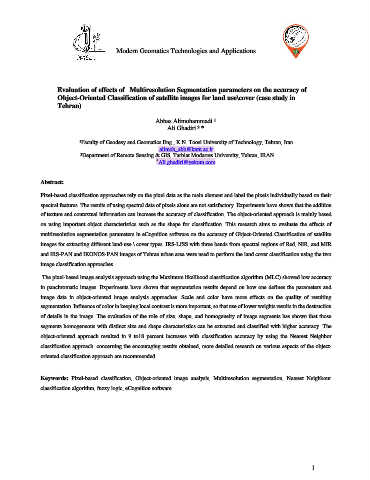Page 322 - NGTU_paper_withoutVideo
P. 322
Modern Geomatics Technologies and Applications
Evaluation of effects of Multiresolution Segmentation parameters on the accuracy of
Object-Oriented Classification of satellite images for land use\cover (case study in
Tehran)
Abbas Alimohammadi ¹
Ali Ghadiri ² *
¹Faculty of Geodesy and Geomatics Eng., K.N. Toosi University of Technology, Tehran, Iran
alimoh_abb@kntu.ac.ir
²Department of Remote Sensing & GIS, Tarbiat Modarres University, Tehran, IRAN
* Ali.ghadiri@yekom.com
Abstract:
Pixel-based classification approaches rely on the pixel data as the main element and label the pixels individually based on their
spectral features. The results of using spectral data of pixels alone are not satisfactory. Experiments have shown that the addition
of texture and contextual information can increase the accuracy of classification. The object-oriented approach is mainly based
on using important object characteristics such as the shape for classification. This research aims to evaluate the effects of
multiresolution segmentation parameters in eCognition software on the accuracy of Object-Oriented Classification of satellite
images for extracting different land-use \ cover types. IRS-LISS with three bands from spectral regions of Red, NIR, and MIR
and IRS-PAN and IKONOS-PAN images of Tehran urban area were used to perform the land cover classification using the two
image classification approaches.
The pixel-based image analysis approach using the Maximum likelihood classification algorithm (MLC) showed low accuracy
in panchromatic images. Experiments have shown that segmentation results depend on how one defines the parameters and
image data in object-oriented image analysis approaches. Scale and color have more effects on the quality of resulting
segmentation. Influence of color in keeping local contrast is more important, so that use of lower weights results in the destruction
of details in the image. The evaluation of the role of size, shape, and homogeneity of image segments has shown that those
segments homogeneous with distinct size and shape characteristics can be extracted and classified with higher accuracy. The
object-oriented approach resulted in 9 to18 percent increases with classification accuracy by using the Nearest Neighbor
classification approach. concerning the encouraging results obtained, more detailed research on various aspects of the object-
oriented classification approach are recommended.
Keywords: Pixel-based classification, Object-oriented image analysis, Multiresolution segmentation, Nearest Neighbour
classification algorithm, fuzzy logic, eCognition software
1

